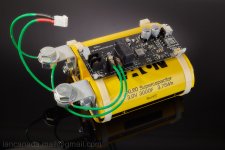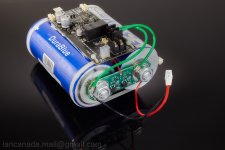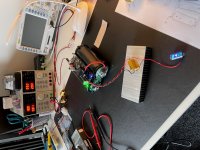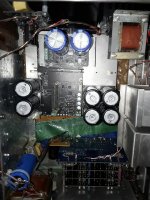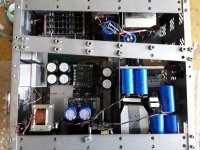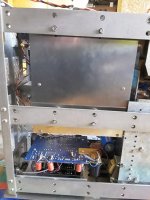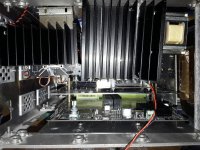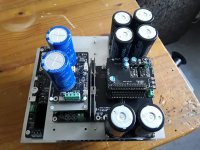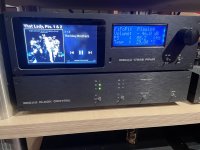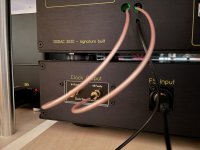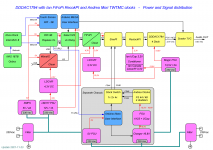No, it cannot. it (mcfifo) has multichannel i2s input and multichannel i2s output. it cannot do any signal processing, or duplication. you may feed it 2 channels input, for 2 channels output. 4 channels input, for 4 channels output, 6, 8 input, 6, 8 output. the input = the output. none of ths is USB of course, you need a standalone USB -> multi channel i2s convertor before MCFIFO. so RPI/PC with DSP->USB->i2s->MCFIFO->dac/s
not sure about the most recent okto, but the first was based on opa1632 iirc. definitely a fairly straight forward opamp/IC IV stage though yes. Myself I prefer to use 1, or 2 multichannel dacs running on the same local clock (for 4-16 channels), especially with FIR. that way it is guaranteed the channels stay perfectly in sync and the correction works. I believe this avoids more issues than it causes. there is not really a reason to do something so extreme to create several dac channels that will be combined together at the left and right speakers anyway. You dont need 4, or 8 individual dacs, when 4 of them are used to describe the same left or right channel information. What would be the point of that? they are split from the same signal and recombined into the same channel/speaker
yes, you can use your own FIR uploaded to the ESS, but if its using the internal DSP, it is somewhat limited vs doing it externally. I would do that externally, if that was my objective.
not sure about the most recent okto, but the first was based on opa1632 iirc. definitely a fairly straight forward opamp/IC IV stage though yes. Myself I prefer to use 1, or 2 multichannel dacs running on the same local clock (for 4-16 channels), especially with FIR. that way it is guaranteed the channels stay perfectly in sync and the correction works. I believe this avoids more issues than it causes. there is not really a reason to do something so extreme to create several dac channels that will be combined together at the left and right speakers anyway. You dont need 4, or 8 individual dacs, when 4 of them are used to describe the same left or right channel information. What would be the point of that? they are split from the same signal and recombined into the same channel/speaker
yes, you can use your own FIR uploaded to the ESS, but if its using the internal DSP, it is somewhat limited vs doing it externally. I would do that externally, if that was my objective.
Last edited:
I am still acquiring parts for my multichannel DAC build. I have the McFIFO. It can take in multiple I2S data channels, but only one set of the clock signals. The McDual clock card can split the data into one to four DACs. The OKTO DAC uses one Sabre DAC chip which can handle 2 to 8 channels. In my case I am using four AK4493 DAC cards. You can feed the multichannel signal from a computer via USB/I2S converter. There are two modules that I am aware of: miniDSP's MCH streamer and DIYINHK's multichannel module. As far as I am aware there is not a way to transport the multichannel I2S signals between the MCFIFO and a DAC with a USB input like the OKTO DAC. You would need to build the MCFIFO and the DAC close together in the same box.
Thats what multi-channel i2s is, singular wordclock and sample clock, with multiple data lines. the MCFIFO clock board does not split anything. I think its best to avoid that language here, when we have a digital crossover in the chain that is doing that job and it appears there is already some confusion over the capabilities. it has multiple outputs that it receives and reclocks, from the fifo, only if there was multichannel input.
Last edited:
No problem. My main point regarding multichannel vs individual dacs, was with regard to crosstalk. the usual reasons to do such a thing, would be to:
A. parallel more dacs, thus lowering distortion
comments: this isn't really required at this level of performance IMO, but fair enough if that's your reason.
B. to minimise crosstalk between channels.
comments: with a well designed PCB and independent l/r regulators and references, this is already very very low and in the case of a digital XO, where half the channels are used in combination for the left channel and half for the right, it is of extremely minimal benefit, if not fully inconsequential IMO. My reasoning?, Even if some tiny amount of signal bleeds into the next dac, that dac is being used to describe the same left or right channel anyway, just a different frequency band of that left or right full range signal and lets just say there is a whole lot more crosstalk between drivers in the same enclosure, than any dac you might care to build 🙂 that's the whole point of a multi way speaker. This is a MUCH different situation than if talking about crosstalk between left and right signals. I support the use of 2 x 9028pro to push the envelope for 2-16 channels, using an individual dac to render each set of left or right drivers, kinda 'dual mono' but the difference is likely to be academic, as long as the 'single' dac layout and power supply is good. You are already using dual mono supply and power amps, so I would not expect that to be difficult to measure, let alone hear.
OK, that's fully off topic, so the last you will hear of it from me. It was an important realization for me, when I had it, so thought I would pass it on.
A. parallel more dacs, thus lowering distortion
comments: this isn't really required at this level of performance IMO, but fair enough if that's your reason.
B. to minimise crosstalk between channels.
comments: with a well designed PCB and independent l/r regulators and references, this is already very very low and in the case of a digital XO, where half the channels are used in combination for the left channel and half for the right, it is of extremely minimal benefit, if not fully inconsequential IMO. My reasoning?, Even if some tiny amount of signal bleeds into the next dac, that dac is being used to describe the same left or right channel anyway, just a different frequency band of that left or right full range signal and lets just say there is a whole lot more crosstalk between drivers in the same enclosure, than any dac you might care to build 🙂 that's the whole point of a multi way speaker. This is a MUCH different situation than if talking about crosstalk between left and right signals. I support the use of 2 x 9028pro to push the envelope for 2-16 channels, using an individual dac to render each set of left or right drivers, kinda 'dual mono' but the difference is likely to be academic, as long as the 'single' dac layout and power supply is good. You are already using dual mono supply and power amps, so I would not expect that to be difficult to measure, let alone hear.
OK, that's fully off topic, so the last you will hear of it from me. It was an important realization for me, when I had it, so thought I would pass it on.
UcPure with Eaton 3000F/3V ultracapacitors report after 10 days of break-in
As the power supply of SinePi and FifoPi clean side, UcPure with the Eaton XL60-3R0308T-R 3000F/3V ultracapacitors have continuously been-in my system for more than 10 days. I have to say the break-in really makes a difference. Step by step, the sound changed better and better, and I like them more and more. Here are some reports
1. About the balancing voltage
I didn’t use a balancer board for the two Eaton XL60-3R0308T-R 3000F/3V ultracapacitors because I think the headroom voltage is big enough. Now after running continuous for 10 days, the voltages on the two ultracapacitors are 1.65V and 1.75V when fully charged. The voltage difference is just 0.1V, better than I thought. That's pretty good. I’ll still keep watching the voltages just to make sure there will be no problem for even longer. But for safety reasons, I still recommend use the balancer board for the ultracapacitors.
2. About the sound quality
I have two UcPure setups, one with the Eaton XL60-3R0308T-R 3000F/3V ultracapacitors, and the other one with the Maxwell 3000F/2.7V caps. I got them carefully compared at the SinePi/FifoPi clean side power supply position. I can say, both of them sound great, better than all the active regualtors/LDOs I have ever had, and also, even better than the 3.3V LifePO4 battery power supplies. The sound quality difference between two different 3000F ultracapacitors was very small. But I can still hear some differences, mainly in style, though the difference was just minor.
A. The Maxwell 3000F/2.7V caps tend to be warmer, nature and feels a little bit more musical. Overall, just a little bit more analog and vivid.
B. The Eaton XL60-3R0308T-R 3000F/3V ultracapacitors tend to have a wider and deeper sound stage. A little bit more detail and dynamic. The image pin point feeling was also a litter bit better.
To be honest, I really can not decide which one is better. Both of them are equally great for me. I’m happy with either of them. The good thing is that Mouser still keeps Eaton XL60-3R0308T-R in stock.
Again, the comparison test was just based on my real listening experiences. But it was just my own subjective feelings. And could combine with psychology and other undetermined conditions. So, if there is any question, please trust your own listening test.
Here are some discusses about why SinePi needs a good power supply for more improvement:
As a bridge between phase domain and time domain, I've found that the SinePi is even more sensitive (audible) to good power supplies than the external sine oscillators themselves . The reason could be that since the phase noise of a sine clock isn't that much sensitive to the amplitude, the sine clock tends to keep that good phase noise performance as long as signal integrity (impedance matching, good cables, filters..) is well implemented. However, when converting a sine clock into square wave, the noise on the power supply rails (amplitude) can be very easily modulated into the raising and falling edges and become time jitter. It's just what I think but I could be wrong.
Regards,
Ian
Other links of the discussion
1.https://www.diyaudio.com/forums/dig...mate-weapon-fight-jitter-657.html#post6668751
2.https://www.diyaudio.com/forums/dig...mate-weapon-fight-jitter-660.html#post6671042
3.https://www.diyaudio.com/forums/dig...mate-weapon-fight-jitter-662.html#post6675622
4.https://www.diyaudio.com/forums/dig...mate-weapon-fight-jitter-664.html#post6678025
5.https://www.diyaudio.com/forums/dig...mate-weapon-fight-jitter-673.html#post6686256
6.https://www.diyaudio.com/forums/dig...mate-weapon-fight-jitter-677.html#post6690153
7.https://www.diyaudio.com/forums/dig...mate-weapon-fight-jitter-682.html#post6704886
8.https://www.diyaudio.com/forums/dig...mate-weapon-fight-jitter-687.html#post6718041
9.https://www.diyaudio.com/forums/dig...mate-weapon-fight-jitter-694.html#post6741950
10.https://www.diyaudio.com/forums/dig...mate-weapon-fight-jitter-710.html#post6756214
11.https://www.diyaudio.com/forums/dig...mate-weapon-fight-jitter-714.html#post6764589
12.https://www.diyaudio.com/forums/dig...mate-weapon-fight-jitter-731.html#post6813401
13.https://www.diyaudio.com/forums/dig...mate-weapon-fight-jitter-736.html#post6821900
As the power supply of SinePi and FifoPi clean side, UcPure with the Eaton XL60-3R0308T-R 3000F/3V ultracapacitors have continuously been-in my system for more than 10 days. I have to say the break-in really makes a difference. Step by step, the sound changed better and better, and I like them more and more. Here are some reports
1. About the balancing voltage
I didn’t use a balancer board for the two Eaton XL60-3R0308T-R 3000F/3V ultracapacitors because I think the headroom voltage is big enough. Now after running continuous for 10 days, the voltages on the two ultracapacitors are 1.65V and 1.75V when fully charged. The voltage difference is just 0.1V, better than I thought. That's pretty good. I’ll still keep watching the voltages just to make sure there will be no problem for even longer. But for safety reasons, I still recommend use the balancer board for the ultracapacitors.
2. About the sound quality
I have two UcPure setups, one with the Eaton XL60-3R0308T-R 3000F/3V ultracapacitors, and the other one with the Maxwell 3000F/2.7V caps. I got them carefully compared at the SinePi/FifoPi clean side power supply position. I can say, both of them sound great, better than all the active regualtors/LDOs I have ever had, and also, even better than the 3.3V LifePO4 battery power supplies. The sound quality difference between two different 3000F ultracapacitors was very small. But I can still hear some differences, mainly in style, though the difference was just minor.
A. The Maxwell 3000F/2.7V caps tend to be warmer, nature and feels a little bit more musical. Overall, just a little bit more analog and vivid.
B. The Eaton XL60-3R0308T-R 3000F/3V ultracapacitors tend to have a wider and deeper sound stage. A little bit more detail and dynamic. The image pin point feeling was also a litter bit better.
To be honest, I really can not decide which one is better. Both of them are equally great for me. I’m happy with either of them. The good thing is that Mouser still keeps Eaton XL60-3R0308T-R in stock.
Again, the comparison test was just based on my real listening experiences. But it was just my own subjective feelings. And could combine with psychology and other undetermined conditions. So, if there is any question, please trust your own listening test.
Here are some discusses about why SinePi needs a good power supply for more improvement:
As a bridge between phase domain and time domain, I've found that the SinePi is even more sensitive (audible) to good power supplies than the external sine oscillators themselves . The reason could be that since the phase noise of a sine clock isn't that much sensitive to the amplitude, the sine clock tends to keep that good phase noise performance as long as signal integrity (impedance matching, good cables, filters..) is well implemented. However, when converting a sine clock into square wave, the noise on the power supply rails (amplitude) can be very easily modulated into the raising and falling edges and become time jitter. It's just what I think but I could be wrong.
Regards,
Ian
Other links of the discussion
1.https://www.diyaudio.com/forums/dig...mate-weapon-fight-jitter-657.html#post6668751
2.https://www.diyaudio.com/forums/dig...mate-weapon-fight-jitter-660.html#post6671042
3.https://www.diyaudio.com/forums/dig...mate-weapon-fight-jitter-662.html#post6675622
4.https://www.diyaudio.com/forums/dig...mate-weapon-fight-jitter-664.html#post6678025
5.https://www.diyaudio.com/forums/dig...mate-weapon-fight-jitter-673.html#post6686256
6.https://www.diyaudio.com/forums/dig...mate-weapon-fight-jitter-677.html#post6690153
7.https://www.diyaudio.com/forums/dig...mate-weapon-fight-jitter-682.html#post6704886
8.https://www.diyaudio.com/forums/dig...mate-weapon-fight-jitter-687.html#post6718041
9.https://www.diyaudio.com/forums/dig...mate-weapon-fight-jitter-694.html#post6741950
10.https://www.diyaudio.com/forums/dig...mate-weapon-fight-jitter-710.html#post6756214
11.https://www.diyaudio.com/forums/dig...mate-weapon-fight-jitter-714.html#post6764589
12.https://www.diyaudio.com/forums/dig...mate-weapon-fight-jitter-731.html#post6813401
13.https://www.diyaudio.com/forums/dig...mate-weapon-fight-jitter-736.html#post6821900
Attachments
Last edited:
@drone
FifoPi works for CD-Pro I2S, but it needs a XO in frequencies of 16.9344 or 33.8688 MHz because of the 48Fs.
Regards,
Ian
FifoPi works for CD-Pro I2S, but it needs a XO in frequencies of 16.9344 or 33.8688 MHz because of the 48Fs.
Regards,
Ian
Last edited:
@drone
FifoPi works for CD-Pro I2S, but it needs a XO in frequencies of 16.9344 or 33.8688 MHz because of the 48Fs.
Regards,
Ian
Hi,
thank you.
So if I want to build a RPi-Streamer with I2S in over HDMI (StationPi Pro?) I would need to change the 48fs of Cd-pro to 64fs. Is there any advice how to do so?
BR
Branko
@drone
FifoPi doesn't change the 48Fs into 64Fs. HdmiPi and TransportPi are also have no problem with 48Fs. The only thing is that you have to make sure your DAC works for 48Fs. (There will be no problem if your DAC was working with the I2S from your CD-Pro)
Ian
FifoPi doesn't change the 48Fs into 64Fs. HdmiPi and TransportPi are also have no problem with 48Fs. The only thing is that you have to make sure your DAC works for 48Fs. (There will be no problem if your DAC was working with the I2S from your CD-Pro)
Ian
Hi @iancanada
I have very good results in my DAC reclocking with KALI. For my next project I would like to try FIFO PI reclocker in a maxed out configuration. Supercap PSU, fancy clocks, HDMI interfaces etc
There is a room correction involved, all audio data is resampled to 96kHz. So it is a single XO needed for this system.
What is the best clock option by now? Is it the Andrea Mori clock with Oven Kit and Sine Pi? I can't find the well tempered clock online. Any ideas where to buy?
Peter
I have very good results in my DAC reclocking with KALI. For my next project I would like to try FIFO PI reclocker in a maxed out configuration. Supercap PSU, fancy clocks, HDMI interfaces etc
There is a room correction involved, all audio data is resampled to 96kHz. So it is a single XO needed for this system.
What is the best clock option by now? Is it the Andrea Mori clock with Oven Kit and Sine Pi? I can't find the well tempered clock online. Any ideas where to buy?
Peter
If you want to buy Andrea's WTMC, you can contact him through his web site,
THE WELL Audio – diy audio devices
For a comparison of his clock and other low noise clocks you can read DDDAC's blog here...DDDAC - Sharing my DIY audiophile Projects
THE WELL Audio – diy audio devices
For a comparison of his clock and other low noise clocks you can read DDDAC's blog here...DDDAC - Sharing my DIY audiophile Projects
Hello,
Some photos showing how the fifo tower will be mounted in my DDDAC chassis.
As you can see the '' mainframe '' has been constructed using 3 stainless steel bars going from left to right on the top side and the bottom side . These bars are not welded to the left and right side but use welded nuts in order to be able to remove them when you need to move in a big part like the Fifo tower.
YES, lots of welded nuts because i wanted to be able to use them to mount the bottom or top plate and mounting a construction like the fifo tower.
In the photo it is just temporarily mounted using some rubber grommets and small M4 bolts that pass through the M6 welded nuts. Just want the tower to be safely fixed. No matter what seize of supercaps are used i want the tower to stay exactly where it is ( can move 1 millimeter or so because of the grommets) so if the chassis will be moved one way or another there will never be short circuit because something moved.
Suppose a friend wanted to try your creation at home and after he installed it, switched it on he only hears a strange noise ending with a final boom. Chances are small you will say of course.
The lifepo4 board will be ''fed'' by the supply designed by Doede mounted right above the circuit. The present supply will give the 5 volt for the Raspberry, both supplies for the fifopi Q3 ( both 3,3 volt!) and the 3,3 volt for the reclockpi.
Surely Ucpure should be better BUT first get this tower working. AT LEAST i managed to get short power supply connections!
Yesterday i discovered the ''biggest '' cap on the Fifopi board is missing . I try to find out the details about this C29 cap but the photos i found online are not enough. Which cap i can use here THAT i can solder myself without getting into trouble? I wouldnt mind if it has two leads that you normally see for through hole mounting . A Maybe i have some Oscon somewhere but not 680 and probably higher voltage. I have one Oscon 180/20 volt and Black Gate NX 100/16 volt.
Sinepi is still at Dutch customs since 12 november but still wanting to have everything ready end of this month.
Greetings, Eduard
Some photos showing how the fifo tower will be mounted in my DDDAC chassis.
As you can see the '' mainframe '' has been constructed using 3 stainless steel bars going from left to right on the top side and the bottom side . These bars are not welded to the left and right side but use welded nuts in order to be able to remove them when you need to move in a big part like the Fifo tower.
YES, lots of welded nuts because i wanted to be able to use them to mount the bottom or top plate and mounting a construction like the fifo tower.
In the photo it is just temporarily mounted using some rubber grommets and small M4 bolts that pass through the M6 welded nuts. Just want the tower to be safely fixed. No matter what seize of supercaps are used i want the tower to stay exactly where it is ( can move 1 millimeter or so because of the grommets) so if the chassis will be moved one way or another there will never be short circuit because something moved.
Suppose a friend wanted to try your creation at home and after he installed it, switched it on he only hears a strange noise ending with a final boom. Chances are small you will say of course.
The lifepo4 board will be ''fed'' by the supply designed by Doede mounted right above the circuit. The present supply will give the 5 volt for the Raspberry, both supplies for the fifopi Q3 ( both 3,3 volt!) and the 3,3 volt for the reclockpi.
Surely Ucpure should be better BUT first get this tower working. AT LEAST i managed to get short power supply connections!
Yesterday i discovered the ''biggest '' cap on the Fifopi board is missing . I try to find out the details about this C29 cap but the photos i found online are not enough. Which cap i can use here THAT i can solder myself without getting into trouble? I wouldnt mind if it has two leads that you normally see for through hole mounting . A Maybe i have some Oscon somewhere but not 680 and probably higher voltage. I have one Oscon 180/20 volt and Black Gate NX 100/16 volt.
Sinepi is still at Dutch customs since 12 november but still wanting to have everything ready end of this month.
Greetings, Eduard
Attachments
Hello,
I found some caps at Mouser that will do the job.
No need for diyaudio.com for this.
Greetings,Eduard
I found some caps at Mouser that will do the job.
No need for diyaudio.com for this.
Greetings,Eduard
If you want to buy Andrea's WTMC, you can contact him through his web site,
THE WELL Audio – diy audio devices
For a comparison of his clock and other low noise clocks you can read DDDAC's blog here...DDDAC - Sharing my DIY audiophile Projects
great source! thank you!
I will get in touch with Andrea.
Currently I am using FIFO reclocker in my own PCM1704 DAC. For good sound, it is mandatory to use the FIFO.
Just to have some real commercial world comparison, I had to have the holo spring III DAC. This device delivers a flawless J Test itself. I was really surprised, the reclocker still made a huge difference in sound.....
The signal quality fed into the reclocker makes some slight audible difference too..... There is always some room for improvement left 😉
I believe the Holo Spring doesn't have built-in reclocking, but the Holo May does.
I agree that the sound quality benefits of reclocking are not subtle. I too was baffled when I stuck a Kali in front of my Soekris dam1121 (which is said to do reclocking, but it's more adaptive clocking because it continuously adjusts itself to the input signal -- which from a RPi is unevenly spaced and so continuously adjusting -- not a "tight" clock at all).
Have fun with your endeavours, I'm interested how Ian's maxed-out package will compare to the simple but perhaps cost-effective Kali.
I agree that the sound quality benefits of reclocking are not subtle. I too was baffled when I stuck a Kali in front of my Soekris dam1121 (which is said to do reclocking, but it's more adaptive clocking because it continuously adjusts itself to the input signal -- which from a RPi is unevenly spaced and so continuously adjusting -- not a "tight" clock at all).
Have fun with your endeavours, I'm interested how Ian's maxed-out package will compare to the simple but perhaps cost-effective Kali.
FIFO reclocking should not be needed for asynchronous USB. A single or two stage D-flip flop reclocker might still be helpful in some cases.
However, FIFO reclocking can be very helpful for SPDIF/TOSLINK/AES and or HDMI sources. The only downside to FIFO is cost, complexity, and the time delay. For some applications any time delay over 5ms is not okay, say, maybe for realtime monitoring in a recording studio. When FIFO does not meet requirements then carefully implemented ASRC is the next best thing. IME most implementation of ASRC are less than optimal.
However, FIFO reclocking can be very helpful for SPDIF/TOSLINK/AES and or HDMI sources. The only downside to FIFO is cost, complexity, and the time delay. For some applications any time delay over 5ms is not okay, say, maybe for realtime monitoring in a recording studio. When FIFO does not meet requirements then carefully implemented ASRC is the next best thing. IME most implementation of ASRC are less than optimal.
Last edited:
Thanks Ian
Thanks to Ian for great service - I already received my Bubble envelope today. With a new reclockPI and an UC 3,3V (I took the opportunity to also upgrade the power supply for the reclockPI - at least a good outome of the blow up of the reclockPI 😀 )
Just built everything into the existing chassis and (for the time being...) my DAC and external clock system are "Ready" now.
I will report back on the impact or doublers yes/no in the chain on my blog next week or so.
Here are a few pictures and in case you wondered what is inside, also a diagram of all the building blocks. It became a nice blend of DDDAC / Ian / Andrea / Audio Creative....
you can see in the two pictures that the clock automatically adapts to to the track source sample frequency (FS) 🙂
.
Today was not my day to be honest. I was distracted and just blew up my ReclokPI an hour ago.... the very last connection I made before finally closing the the DAC Chassis was not the 3,3 Volt wire but a 12 Volt 😱
---- pssshhht and smoke ------ So need to wait again now to finish my DAC....
well it is a hobby and sh*****t like this happens so now and than
.
Thanks to Ian for great service - I already received my Bubble envelope today. With a new reclockPI and an UC 3,3V (I took the opportunity to also upgrade the power supply for the reclockPI - at least a good outome of the blow up of the reclockPI 😀 )
Just built everything into the existing chassis and (for the time being...) my DAC and external clock system are "Ready" now.
I will report back on the impact or doublers yes/no in the chain on my blog next week or so.
Here are a few pictures and in case you wondered what is inside, also a diagram of all the building blocks. It became a nice blend of DDDAC / Ian / Andrea / Audio Creative....
you can see in the two pictures that the clock automatically adapts to to the track source sample frequency (FS) 🙂
.
Attachments
- Home
- Source & Line
- Digital Line Level
- Asynchronous I2S FIFO project, an ultimate weapon to fight the jitter

